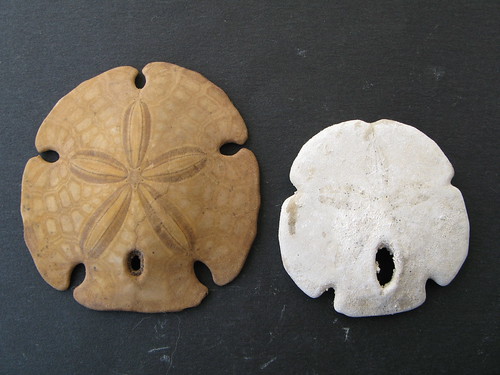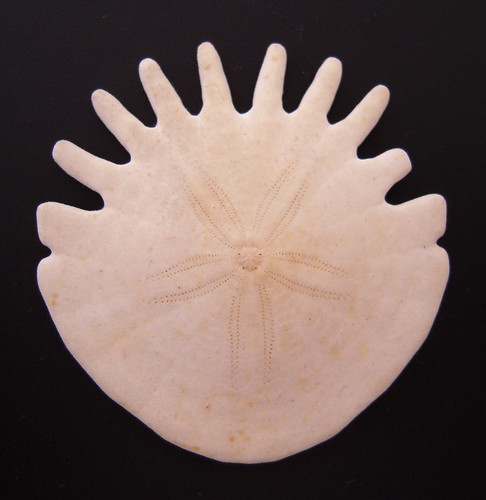 What are those holes in Sand Dollars for???
What are those holes in Sand Dollars for???
So..probably everyone has SEEN sand dollars or knows what a sand dollar is... (just fyi..they are highly modified sea urchins!).
Most live in shallow tropical to temperate water environments all around the world. They largely live in unconsolidated sediment on organic detritus and when they die, their bodies (also called a "test") frequently wash up on beaches and such..
They come in a wide diversity of shapes and forms. If you live in colder type northern climates, you think of sand dollars as looking like this:
 (Echinarachnius parma from the NHM database)
(Echinarachnius parma from the NHM database)
BUT if you live in tropical climates, sand dollars look more like this...
These are familiar to the tropical beach-goer and names such as "keyhole sand dollar" or "keyhole urchins". One of the most obvious features are the presence of BIG holes or prominent notches on the sides of the test (aka the body). These are called lunules.
This is their story.
The data and results for this are taken from a neat paper by Malcolm Telford (1981-Hydrodynamic Interpretation of Sand Dollar Morphology. Bull. Mar. Sci .31(3):605-622) who takes a biophysics/ hydrodynamic interpretation.
Our understanding starts with this basic tutorial on (oddly enough) how airplanes fly.
While watching this, replace "airplane wing" with "sand dollar"
Let's take a peek!
Okay...So, what's going on here?
Sand dollars, such as Echinarachnius, tested with wind tunnels and dye+water flow simulators where lunules were ABSENT showed a relatively high coefficient of lift!
What that means is that the same pressure differential that makes airplanes fly is accomplished more easily where lunules are absent.
Essentially the hydrodynamic flow moves over the discoid form of a sand dollar like Echinarachnius smoothly and easily.

But what happens with a "keyhole" sand dollar such as Encope or Mellita??
 |
| Image by Jani Oravisjärvi |
Lunules REDUCE lift either by interfering with hydrodynamic flow or by "relieving" pressure from the under surface!! i.e., they INTERRUPT and LOWER the coefficient of lift!
To put this simply..they KEEP THE SAND DOLLAR FROM BEING "BLOWN" away!!
 One quotation from his paper sentence sums up the important bit very nicely
One quotation from his paper sentence sums up the important bit very nicelyThe lunules of Mellita reduce lift by providing channels to bleed off excess pressure from the oral surface. This is shown by the clear flow of water (which was marked with dye)...through the lunules.Telford used three different sea urchin tests as models, and each one had its own specific modifications and stories..

For example, the edges of the body and around the lunules of this Encope for example are actually modified into pressure drainage channels (i.e., places where lift is further weakened)!
Subtle modifications, such as the absence of tube feet in these areas are also present.
After seeing how lunules and notches can affect and help these animals from attaining "lift-off" one has to wonder then, what happens with critters like these rotulid sand dollars with the odd notches and lunules below??
 |
| Image by Bellwizard via Flickr |
But how do the urchins WITHOUT lunules solve this problem?? Go here to see all about sand dollar weight belts!

Thank you for this fantastic explanation of lunules! And am looking forward to learn about those sand dollars without holes.
ReplyDeleteWe have both kinds on our shores and I've long wondered about why some don't have holes.
I learn a lot from your blog. Thank you!
Thank you for this information!I'm using it for a report on sand dollars. I will surely give you credit! I can't wait to know what sand dollars do without lunules!
ReplyDeleteMaya age 10
That was very interesting and very clearly stated! Thanks for sharing your love of echinoderms and talent of understanding them with everyone!
ReplyDeleteAre the small holes on the top of cold water sand dollars shrunken lunules?
ReplyDeleteThanks I have been debating that for a long time
DeleteIf you are referring to the tiny holes that are located on the petaloid region (as seen in this picture):
ReplyDeletehttp://www.flickr.com/photos/boyercartinfo/4307674012/
those holes are actually gonopores. Those are where the reproductive cells are released. Dendraster and the Echinarachnius (the two cold-water sand dollars that most are familiar with) don't have lunules (the large openings through the test).
Ohh cool thanks
DeleteHi Chris,
ReplyDeleteGood stuff. Here in the Ivory Coast sand dollars have lunules but also a different shape as half of the dollar has a teeth-like edge. Bit hard to explain without a pic, but I'm sure you know what I mean. How can that be explained? Do the teeth have the same function as lunules, for instance to cope with strong riptides? Thanks.
Hi,
ReplyDeletethanks for the kind words. I think the sand dollars you mean are these right? Rotulids?
http://www.echinoids.nl/Echinoids/Heliophora-orbiculus/Heliophora-orbiculus.htm
Yes. they are odd.. I look forward to hearing about their unusual shape!
This comment has been removed by the author.
ReplyDeleteFollowing the interpretations of the other sand dollars, I would venture to guess that the test shape is some adaptation/defense against the rip tides. The expression is probably affected by local ocean chemistry and the evolutionary history of the sand dollars in question.
ReplyDeleteA colleague of mine at the California Academy of Sciences in San Francisco is a specialist in sand dollars and might be better at answering your questions: His name is Rich Mooi and he can be contacted here:
http://research.calacademy.org/izg/staff
good luck!
This comment has been removed by the author.
ReplyDeleteHello Chris!
ReplyDeleteWonderful explanation, and the 'airplane' video was a great way to make it simple.
I know it's three years after the original post, but if you happen to see this, thanks so much!
I needed this information for a presentation, and you will sure surely be credited.
Thanks again, and good luck in your searches!
I'm always watching! thanks for the kind words!
ReplyDeleteI have absolutely LOVED this post - fantastic to read - great explanations, I want to read everything you have written! :D
ReplyDeleteWhen I was a kid, I recall being given an explanation for the little "drill" holes in sand dollars as having been inflicted by some sort of parasitic organism. Reading this blog entry, I now assume that was incorrect. Might there have been any truth to that explanation?
ReplyDeleteI've never heard of any account of a parasite creating holes in sand dollars. Sometimes in other areas, moon snails drill holes into their prey to eat them, but those are usually clams or snails not sand dollars.
ReplyDeleteVery nicely expressed, thanks, Chris. May I bring your readers up to date with a new piece of information? I have just written a book called "Flying Sand Dollars, Left-handed Crabs, Giant Earwigs, and Other Curiosities" Interested readers can find more about the book and about me at http://www.malcolmtelford.com/ Hope you enjoy the book and the site!
ReplyDeleteMalcolm Telford